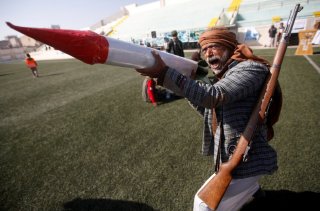The Houthis Might be Using North Korean Missiles
North Korean missiles may very well have found their way across Asia.
Here's What You Need to Remember: The Houthis inherited from the defunct Yemeni military a large number of Soviet-exported Scuds as well as North Korean-made Scuds called “Hwasong-6s.”
It’s possible the missile strikes that badly damaged a key Saudi oil facility on Sept. 14, 2019 involved far-flying drones firing small, guided munitions.
Yemen's Houthi rebels, who have been at war with a Saudi-Emirati coalition since 2015, claimed responsibility for the coordinated attacks on the Aramco sites, which lie around 800 miles from the Saudi Arabia-Yemen border. Iran’s hard-line Revolutionary Guard Corps in the past has supplied the Houthis with weaponry including drones.
But it’s worth noting that the Houthis also possess a surprisingly sophisticated arsenal of homemade ballistic and cruise missiles possessing the range performance to strike targets deep inside Saudi Arabia.
According to aviation expert Tom Cooper, the main weapon in the Houthi arsenal is the Burkan, a modified version of the Soviet R-17E Scud rocket that’s around five feet longer than the baseline missile and some 4,400 pounds heavier and can travel farther than 500 miles.
The Houthis inherited from the defunct Yemeni military a large number of Soviet-exported Scuds as well as North Korean-made Scuds called “Hwasong-6s.”
Iraq in the 1980s modified its own Scuds to the long-range “Al Hussein” standard, which is similar to the Burkan. An Iraqi engineer told Cooper about the modification effort, perhaps offering a perspective on the origins of the Houthis’ long-range rocket force.
“The R-17E is quite simple,” the engineer told Cooper. “From its tip towards the rear, it contains a warhead, then a room for equipment like gyro and timer, then the fuel tank which is about 1.35 meters long, and the oxidizer tank that is about 2.7 meters long. At the rear end is the engine.”
Stretching the missile body is no problem, but stretching fuel tanks is one. The simplest solution — the one we applied early on — is to take a tank from another missile, cut its central section and insert it into the tank of the modified missile.
Before launching domestic production of stretched fuel tanks, we used tanks from three R-17Es to create one for the Al Hussein missile. The problem is the cutting of that fuel tank — doing that with usually available means results in destruction of the tank. We found an engineer trained in England before 1951. He modified the cutting machine so that the tank was not damaged.
Another problem was welding of the new, extended fuel tank. We had to use argon for welding.
The third problem was the center of gravity. During early trials, missiles came back down horizontally and slowly, and failed to explode. The solution was to move air pressure cylinders from the rear to the front of the missile, near the warhead, to make its nose heavier.
The final problem was that of batteries. Some of missiles fired at Tehran in 1988 failed to detonate for this reason. In April 1988, we installed a second battery, and this never happened again.
“While this is hardly definitive proof that the Yemenis stretched R-17Es or Hwasong-6 on their own, it at least indicates that modifying older Scud-style missiles for longer range is possible.”
The Houthis also possess a cruise missile called the “Quds 1,” which according to missile expert Fabian Hinz could be a copy of the Iranian Soumar missile -- itself a copy of the Russian Kh-55.
Noting the overall similarity in design with the Soumar, many observers claimed Iran had simply smuggled it to Yemen where the Houthis gave it a new paintjob and a new name, as they had done before with the Qiam. …
[But] there are quite a few differences. Differences between the Quds 1 and the Soumar include the entire booster design, the wing position, the Quds 1’s fixed wings, the shape of the nose cone, the shape of the aft fuselage, the position of the stabilizers and the shape of the engine cover and exhaust. …
There is yet another apparent difference between the Quds 1 and the Soumar/Hoveyzeh: size. A quick measurement using Mk.1 eyeball reveals that the Quds 1 seems to be smaller in diameter than the Soumar.
Also, the Quds 1 features a Czech-made TJ100 engine, which is less powerful than the Russian-made engine on the Kh-55.
“All of this leaves the question of just who developed and built the Quds 1,” Hinz wrote. “The idea that impoverished war-torn Yemen would be able to develop a cruise missile without any outside assistance seems far-fetched. Iran’s previous supply of missiles to the Houthis and the fact that the country uses TJ100 engines in its drone program do imply that Iran could be behind the Quds 1.”
“However, so far we haven’t seen any trace of the Quds 1 in Iran proper. This riddle is not unique to the Quds 1. Beginning in 2018, several missile systems began to emerge in Yemen that while broadly similar to Iranian-designed systems have no exact Iranian equivalent.”
David Axe served as Defense Editor of the National Interest. He is the author of the graphic novels War Fix, War Is Boring and Machete Squad.
This article first appeared in 2019 and is being reposted due to reader interest.
Image: Reuters

